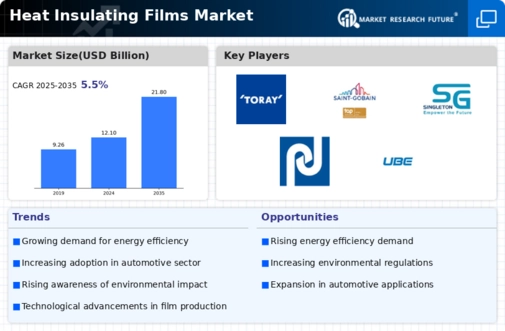Market Growth Projections
The Global Heat Insulating Films Market Industry is poised for substantial growth, with projections indicating an increase from 12.1 USD Billion in 2024 to 21.8 USD Billion by 2035. This growth trajectory suggests a robust demand for heat insulating films driven by various factors, including energy efficiency, technological advancements, and regulatory support. The anticipated CAGR of 5.5% from 2025 to 2035 reflects the industry's potential to adapt to changing market dynamics and consumer preferences. As the market evolves, stakeholders must remain vigilant to capitalize on emerging opportunities and address challenges.
Rising Construction Activities
The resurgence of construction activities globally is a key driver for the Global Heat Insulating Films Market Industry. As urbanization accelerates, the demand for residential and commercial buildings rises, necessitating the incorporation of energy-efficient materials. Heat insulating films are increasingly being utilized in windows and facades to enhance thermal performance. This trend is particularly evident in regions experiencing rapid urban growth, where energy efficiency is a critical consideration. The market is expected to grow at a CAGR of 5.5% from 2025 to 2035, reflecting the ongoing integration of these films in modern construction practices.
Growing Demand for Energy Efficiency
The Global Heat Insulating Films Market Industry is witnessing an increasing demand for energy-efficient solutions across various sectors. Governments worldwide are implementing stringent regulations aimed at reducing energy consumption and greenhouse gas emissions. For instance, energy-efficient buildings are becoming a priority, which drives the adoption of heat insulating films. These films help in maintaining indoor temperatures, thereby reducing reliance on heating and cooling systems. As a result, the market is projected to reach 12.1 USD Billion in 2024, reflecting a growing awareness of energy conservation and sustainability.
Government Initiatives and Incentives
Government initiatives aimed at promoting energy efficiency and sustainability are significantly impacting the Global Heat Insulating Films Market Industry. Various countries are offering incentives for the adoption of energy-efficient technologies, including tax rebates and subsidies for building retrofits. Such policies encourage the use of heat insulating films in both new constructions and renovations. As governments continue to prioritize energy conservation, the market is expected to expand, with projections indicating a potential market size of 21.8 USD Billion by 2035. These initiatives not only stimulate demand but also foster innovation within the industry.
Increased Awareness of Environmental Impact
There is a growing awareness of the environmental impact of traditional building materials, which is influencing the Global Heat Insulating Films Market Industry. Consumers and businesses are becoming more conscious of their carbon footprints and are seeking sustainable alternatives. Heat insulating films contribute to reduced energy consumption and lower emissions, making them an attractive choice for eco-friendly construction. This shift in consumer behavior is likely to drive market growth, as more stakeholders prioritize sustainability in their purchasing decisions, further solidifying the role of heat insulating films in environmentally responsible building practices.
Technological Advancements in Film Production
Innovations in the production of heat insulating films are propelling the Global Heat Insulating Films Market Industry forward. Advanced manufacturing techniques, such as the use of nanotechnology and improved polymer blends, enhance the performance characteristics of these films. These advancements lead to better thermal insulation, durability, and aesthetic appeal. For example, the development of multi-layer films allows for superior insulation properties while maintaining transparency. Such technological progress not only meets consumer expectations but also aligns with the growing trend towards high-performance building materials, potentially increasing market value significantly.



 Source: Secondary Research, Primary Research, Market Research Future Database and Analyst Review
Source: Secondary Research, Primary Research, Market Research Future Database and Analyst Review











